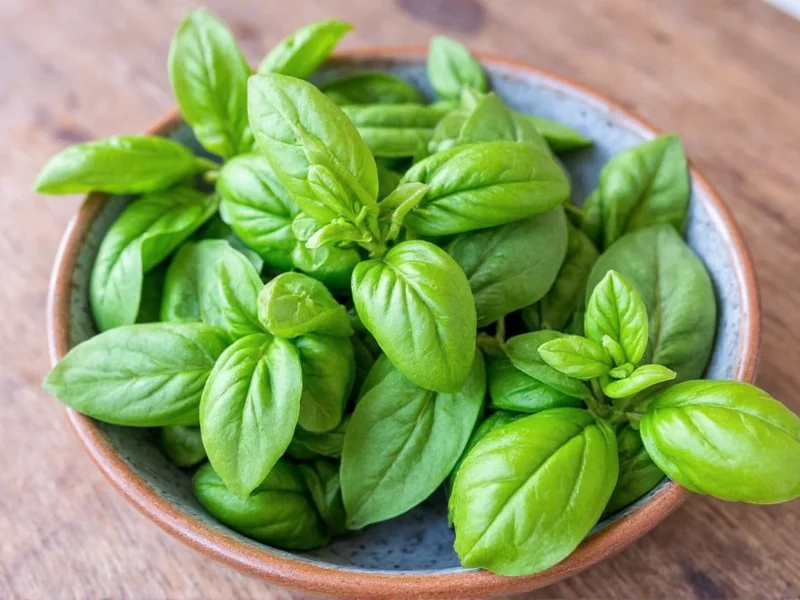Understanding how to properly convert fresh basil to dried basil ensures your recipes maintain the intended flavor profile. Many home cooks and gardeners find themselves with an abundance of fresh basil during summer months and need reliable methods to preserve it for year-round use. Getting the conversion wrong can lead to dishes that are either bland or overwhelmingly herbal.
Why the 3:1 Conversion Ratio Matters
Fresh basil contains approximately 90% water, while dried basil has most of this moisture removed. This dehydration process concentrates the essential oils and flavors, making dried basil significantly more potent by volume. The 3:1 ratio (fresh to dried) has been established through culinary testing as the standard conversion that maintains proper flavor balance in most recipes.
When converting measurements for how to substitute dried basil for fresh in recipes, remember that dried herbs generally require more cooking time to release their full flavor compared to fresh herbs, which are often added near the end of cooking.
Fresh Basil to Dried Basil Conversion Chart
| Measurement | Fresh Basil | Dried Basil |
|---|---|---|
| Teaspoon | 3 teaspoons | 1 teaspoon |
| Tablespoon | 1 tablespoon | 1 teaspoon |
| Cup | 1 cup | ⅓ cup |
| Ounce | 1 ounce | ⅓ ounce |
| Gram | 30 grams | 10 grams |
Effective Methods for Drying Fresh Basil
Before you can convert fresh basil measurements to dried basil equivalents, you need to properly dry your basil. Here are the most reliable methods:
1. Air Drying (Traditional Method)
Bundle 4-5 basil stems together and hang them upside down in a warm, dark, well-ventilated area with low humidity. Cover the bundles with a paper bag with holes punched in it to protect from dust while allowing airflow. This method takes 1-2 weeks. The basil is ready when leaves crumble easily between your fingers.
2. Oven Drying (Faster Method)
Preheat your oven to its lowest setting (ideally 150-170°F or 65-75°C). Spread basil leaves in a single layer on a baking sheet. Place in oven with the door slightly ajar for 2-4 hours, checking frequently to prevent burning. This method preserves more flavor than higher-heat alternatives.
3. Dehydrator Method (Most Consistent Results)
Arrange basil leaves in a single layer on dehydrator trays. Set temperature to 95°F (35°C) and dry for 2-4 hours. Check periodically until leaves are brittle. A dehydrator maintains consistent low heat and airflow, producing the highest quality dried basil with maximum flavor retention.
Proper Storage of Dried Basil
Once you've successfully dried fresh basil at home, proper storage is crucial for maintaining quality:
- Store in airtight glass containers away from light and heat
- Use dark glass jars or opaque containers to protect from light degradation
- Keep in a cool, dark pantry (not above the stove or near dishwasher)
- Properly stored dried basil maintains peak flavor for 6-12 months
- Add a silica gel packet to containers in humid environments to prevent moisture absorption
Always label your containers with the drying date. Over time, dried basil loses potency, so check your supply periodically. Crush a small amount between your fingers - if the aroma is weak, it's time to replace your supply.
Using Dried Basil in Recipes: Timing Matters
When substituting dried basil for fresh in cooking, consider timing:
- Add dried basil early in the cooking process to allow time for rehydration and flavor release
- Dried herbs need 15-20 minutes of cooking time to fully integrate flavors
- Fresh basil is typically added in the last few minutes of cooking or as garnish
- For cold dishes like salads or dressings, reconstitute dried basil by soaking in warm water first
Remember that the fresh to dried basil conversion ratio for pizza might differ slightly from other applications, as pizza's high heat can intensify dried herb flavors. Many pizza enthusiasts prefer a slightly lower ratio (2.5:1) for this specific application.
Flavor Differences to Expect
Dried basil has a more concentrated, slightly different flavor profile than fresh:
- Fresh basil offers bright, sweet, slightly peppery notes with hints of anise
- Dried basil develops earthier, more muted flavors with less of the fresh herb's complexity
- The drying process reduces the volatile oils that give fresh basil its distinctive aroma
- Dried basil works better in long-simmered dishes like soups and stews
- Fresh basil shines in raw applications like pesto, caprese salad, and garnishes
When converting fresh basil to dried for specific recipes, consider these flavor differences and adjust other seasonings accordingly. You may need to increase other herbs or spices slightly to compensate for dried basil's less complex profile.
Troubleshooting Common Conversion Issues
Many home cooks encounter these problems when substituting dried basil for fresh in recipes:
- Too strong flavor: You've likely used too much dried basil. Start with ⅔ of the recommended amount and adjust to taste.
- Weak flavor: Your dried basil may be old or you might not have given it enough cooking time to release flavors.
- Muddy appearance: Adding dried basil too late in cooking prevents proper integration. Add earlier next time.
- Bitter notes: Over-drying or high-heat drying can create bitter compounds. Try a gentler drying method next time.
For the most accurate fresh basil to dried basil measurement conversion for specific dishes, consider the dish's cooking time, liquid content, and other ingredients that might affect herb flavor.











 浙公网安备
33010002000092号
浙公网安备
33010002000092号 浙B2-20120091-4
浙B2-20120091-4